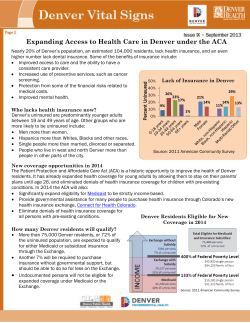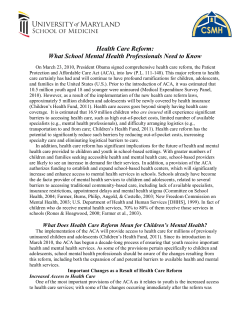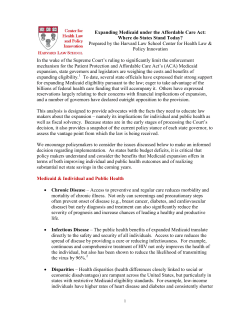
Affordable Care Act Implementation: Through the Cancer Lens Comprehensive Cancer Alliance for Idaho, Annual Meeting September 18, 2013
AffordableCareActImplementation: ThroughtheCancerLens Comprehensive Cancer Alliance for Idaho, Annual Meeting September 18, 2013 Dana Dzwonkowski, Health Expert for Affordable Care Act Implementation State and Local Campaigns, American Cancer Society Cancer Action Network ACAImplementation: ThroughtheCancerLens • ACA Implementation: What has already happened? • The Road to Coverage on January 1, 2014: Open Enrollment • January 1, 2014 ‐The New World of Private Insurance Options ‐The New World for Employer Sponsored Coverage ‐Medicaid Expansion ‐ ACA Impact on Tribes ‐ Issues for 2014 and Beyond • The importance of YOUR STORIES 2010 • Coverage for young Adults • “Doughnut hole” Rebates • Small Business Tax Credits • No Cost Sharing for • Preexisting Condition Insurance Plan (PCIP) • No more recessions • No lifetime Caps • Guaranteed Issue of Insurance for children with preexisting conditions Preventive Care • Payment Reform • Workforce Improvements • Increased Funding for Community Health Centers • New Appeals Options 2011 • Limits on Non‐Medical Spending by Health Plans • No Cost Sharing for Wellness Visits and Preventive Care for Medicare Beneficiaries • “Doughnut Hole” Discounts • Physician Quality Reporting • New Healthcare Innovation Center • New Rate Increase Review Requirements 2012 • Insurance Companies Required to send Consumer Rebate Checks • No Cost Sharing for Well Women Visits • Planning Grants Awarded for State Exchanges • States Evaluate EHB Benchmark Options 2013 • Prevention and Primary Care Incentives in Medicaid and Medicare • Pilot Project on Payment and Delivery Reform • State EHB Benchmark Plans Identified • Exchange Establishment Grants Awarded • Navigator Program Funding Awarded • OPEN ENROLLMENT starts October 1 TimelineforCoverage • Initial Open Enrollment: October 1, 2013 – March 31, 2014 • Annual Enrollment: Oct 15 – Dec 7 • Special enrollment periods for qualifying events • First effective date is January 1, 2014 (must enroll by December 15, 2013) WaystoEnroll In‐person Assistance: • Agents/Brokers • Navigators • In‐Person Assisters • Certified Application Counselors www.healthcare.gov ACA EducationandOutreach • www.healthcare.gov • 1‐800‐318‐2596 (100+ languages) • Enroll America (www.getcoveredamerica.org) • Marketplace ad campaigns • Society/ACS CAN NCIC training Staff training New materials Coveragein2014 • Many won’t feel an impact • Pre‐ACA options still exist • Health Care Law introduces new coverage/protections ‐ ‐ ‐ ‐ ‐ Guaranteed Issue Premium Rating Regulations EHB Out‐of‐Pocket Limits Limits on deductibles for small group plans Coveragein2014:TheIndividualand SmallGroupMarkets • Plans will be sold “inside” and “outside” of the insurance marketplace (exchange) in each state • Inside the Marketplace: access to premium tax credits, cost sharing reductions, ability to do apples to apples comparison of available plans, “metal” levels assigned to plans that convey out‐of‐pocket costs for premiums vs. cost sharing for benefits, EHB required coverage in all plans • Outside the marketplace: EHB coverage and many of the same consumer protection apply to non‐exchange plans, but consumers cannot access premium subsidies or cost sharing reductions if they purchase their plan “outside” the exchange • Each state will have a marketplace: state, federal or partnership Coveragein2014:TheIndividualand SmallGroupMarkets • All small and individual group plans will have to cover Essential Health Benefits based on the state’s chosen “benchmark plan” • Idaho chose a PPO plan from the top 3 largest small group plans sold in 2012: Blue Cross of Idaho Health Service Inc. • A link to the plan summary and prescription drug formulary can be found at: http://www.cms.gov/CCIIO/Resources/Data‐ Resources/Downloads/idaho‐ehb‐benchmark‐plan.pdf Coveragein2014:LargeGroup EmployerMarket • Large Employer is defined as a business having an average of at least 101 employees during the calendar year (in 2014 and 2015 a state can opt to define “large employer as one with an average of at least 51 full time employees in a calendar year) • Employer must either: ‐ Provide health benefits that meet “minimum essential coverage” standards (different than EHB) OR ‐ Pay a “shared responsibility payment” if:no employee coverage is offered; OR if coverage offered does not meet minimum essential coverage standards; or if cost of coverage exceeds 9.5% of employee household income Coveragein2014:LargeGroup EmployerMarket No Offer (“A” Penalty) • $2,000 per full-time employee (minus the first 30) if any fulltime employee receives a premium tax credit Unaffordable or Inadequate Offer (“B” Penalty) • $3,000 per full-time employee who receives a premium tax credit Coveragein2014:Medicaid • Standard Medicaid populations will still remain eligible for Medicaid Coverage (medically frail, income eligible pregnant women etc..) • States choosing to expand Medicaid will be able to provide coverage for all adults under 133% FPL • “Newly eligible” Medicaid recipients will be covered by an “Alternative Benefit Plan” (ABP) chosen in a way similar to the benchmark plan used to define private plans Coveragein2014:Medicaid Coveragein2014:Tribes • 579,000 uninsured American Indians and Alaska Natives will have new opportunities for coverage through the Health Insurance Marketplace. As many as nine out of 10 of those may qualify for financial assistance either through tax credits to purchase coverage in the Marketplace, cost-sharing reductions that will reduce or eliminate out of pocket costs, or through Medicaid if their state expands eligibility. • American Indians and Alaska Natives earning between 100 percent of the federal poverty level (FPL) (or $23,550 for a family of four in 2013, $29,440 in Alaska) and 400 percent of FPL (or $94,200 for a family of four in 2013, $117,760 in Alaska) may be eligible for advance premium tax credits that lower monthly premiums right away. • Certain American Indians and Alaska Natives who purchase health insurance through the Marketplace do not have to pay co-pays or other cost-sharing if their income is under 300 percent of FPL, which is roughly $70,650 for a family of four in 2013 ($88,320 in Alaska). • Certain American Indians and Alaska Natives will have access to special monthly enrollment periods so they may get insurance outside the yearly open enrollment period. Coveragein2014:Tribes • All American Indians and Alaska Natives who are eligible to receive services from an Indian health care provider (as defined in 42 C.F.R. § 447.50) may receive an exemption from the shared responsibility payment if they do not maintain minimum essential coverage under the Affordable Care Act. • Prior to HHS’ announcement of the exemption, only a portion of the American Indian and Alaska Native population – members of federally recognized tribes – would have access to such an exemption. • With greater numbers of American Indians and Alaska Natives with some form of coverage, including Medicaid, the Children’s Health Insurance Program (CHIP) and private insurance, IHS will be better able to provide needed health services. This coverage will improve reimbursements to IHS and will also benefit Indian health programs. IssueWatch •Tobacco rating •Drug access (not included in the formulary) •States not improving access to Medicaid TobaccoRating • Provision of the ACA allowing insurance companies to charge smokers more for their monthly insurance premium (1:1.5) • Problematic for those who smoke and want to quit: higher premium may prove unaffordable and without affordable insurance, no access to smoking cessation benefits guaranteed by the ACA preventive services requirement • States have the option to prohibit tobacco rating by legislative or regulatory action DrugCoverageUndertheACA • Small and Individual Group Plans: a Prescription Drugs benefit is one of the 10 EHB “buckets” for small and individual group plans inside and outside of the state marketplaces ‐ plans must cover the greater of one drug per USP category and class or at least the number of drugs in each category and class as the state benchmark plan ‐ this minimum standard for coverage may fall short for cancer patients ‐ USP class system does not include newly approved drugs or combination therapies; questions still exist regarding how IV drugs will be covered ‐ Drugs considered “EHB” have to be on a plan formulary, non‐formulary drugs not considered EHB, concerns about whether patient out‐of‐pocket costs will go towards annual OOP limit • Medicaid Expansion Population: covered by the state chosen “Alternative Benefit Plan” (ABP), which also must cover prescription drugs as part of an EHB standard ‐ same coverage gap concerns as private insurance ‐ the minimum standard for drug coverage under Medicaid expansion could be less generous the what is required for those covered under standard Medicaid DrugCoverUndertheACA Antiangiogenic Agents Alkylating Agents Alabama Alaska Arizona Arkansas California Colorado Connecticut Delaware DC Florida Georgia Hawaii Idaho Indiana Iowa Kansas Kentucky Louisiana Maine Maryland 7 8 8 6 7 6 8 8 5 6 6 6 8 8 5 8 8 6 8 5 Antiestrogens/M Antimetabolites odifiers 2 2 2 2 2 2 2 2 2 2 2 2 2 2 0 2 2 2 2 2 3 3 3 3 2 2 3 3 3 3 3 3 3 3 2 3 3 3 3 3 Aromatase Enzyme Inhibitors, 3rd Inhibitors Generation Antineoplastics, Other 2 2 3 2 2 2 3 2 1 2 2 2 2 2 2 2 2 2 2 1 5 6 6 3 5 4 6 6 2 2 3 2 6 6 1 6 6 2 6 2 3 3 2 3 3 3 3 3 3 3 3 3 3 3 3 3 3 3 3 3 Molecular Target Inhibitors 3 3 3 3 3 3 3 3 1 1 2 1 3 3 0 3 3 1 3 1 12 12 12 12 12 5 12 12 12 12 11 12 12 12 1 12 12 12 12 12 Monoclonal Antibodies 2 3 3 3 1 1 3 3 0 0 0 0 3 3 0 3 3 0 3 0 DrugCoverageUndertheACA Massachusetts Michigan Minnisota Mississippi Missouri Montana Nebraska Nevada 8 2 5 8 8 8 8 6 2 2 2 2 2 2 2 2 3 3 2 3 3 3 3 3 2 2 2 2 2 3 3 2 6 2 1 5 6 6 6 3 3 3 3 3 3 3 3 3 3 1 1 3 3 3 3 1 12 12 11 12 12 12 12 12 2 0 0 3 3 3 3 0 New Hampshire New Jersey New Mexico New York North Carolina North Dakota Ohio Oklahoma Oregon Pennsylvania Rhode Island South Carolina South Dakota Tennessee Texas Utah Vermont Virginia Washington West Virginia Wisconsin Wyoming 8 5 1 5 6 6 8 6 8 6 8 8 5 6 6 2 8 8 6 8 2 8 2 2 2 2 2 0 2 2 2 2 2 2 0 1 2 2 2 2 2 2 1 2 3 3 1 2 3 3 3 3 3 2 3 3 2 3 3 1 3 3 3 3 1 3 2 1 1 2 2 2 2 2 2 2 2 2 2 2 2 1 3 2 2 2 1 3 6 2 1 2 2 2 6 2 5 3 4 5 1 2 2 1 6 6 2 6 2 5 3 3 3 3 3 3 3 3 3 3 3 3 3 3 3 1 3 3 3 3 3 3 3 1 0 1 1 1 3 1 3 2 2 3 0 2 1 1 3 3 1 3 0 3 12 12 4 11 12 2 12 12 12 13 8 12 1 7 12 8 12 12 11 12 6 12 3 0 0 0 0 1 3 0 3 2 2 3 0 0 0 0 3 3 0 3 0 3 MedicaidExpansion • Supreme Court made Medicaid Expansion a State Option • States must pass legislation to authorize their state Medicaid Department to accept federal dollars to cover newly eligible population (adults under 133% FPL, or $15,281.70 for an individual and $31,321.50 for a family of 4 in 2013) • Federal Government pays 100% of the cost for 2014‐2016 and gradually moves to paying 90% by 2020 and thereafter • Those covered under Medicaid expansion will have access to EHB’s • Every year a state waits on Expansion, they forego a year of 100% federal matching funds • Law does not allow for those under 100% FPL to receive premium subsidies or cost sharing reductions (law was written under the assumption that Expansion would be required, not optional) StateActiononMedicaidExpansion Source: Kaiser Family Foundation PatientStoriesMatter PatientStoriesMatter PatientStoriesMatter APicture(Story)isWorth…You Know • Framed the debate through the cancer lens • Highlight what works (and what doesn’t) through the cancer lens • Bring us those stories! Q&A Thank You!!!!
© Copyright 2025





















